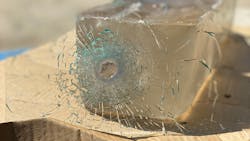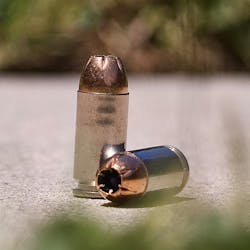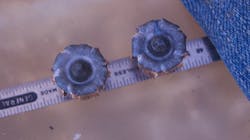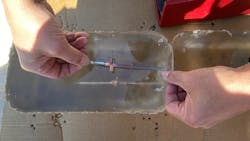Will the New Hydra-Shok Deep Perform?
We tested the new Federal Premium Hydra-Shok Deep cartridges in 9mm and .40 S&W. The Hydra-Shok Deep is marketed as a personal defense cartridge, designed to penetrate 15 inches in bare gelatin, using the FBI testing protocol for cartridge performance.
In 1989, Federal Premium released the Hydra-Shok cartridge. The bullet designed resembled contemporary hollow point bullets, except there was a center post inside the hollow cavity. When the Hydra-Shok was released, it performed dramatically better than many other hollow point cartridges. It was known for dynamic expansion because of a lead post in the center of the hollow point. As it was explained to me 30 years ago, fluids compress against the post, causing the material of the hollow point to peel back quicker and more reliably than just a “normal” hollow point.
This may be the limits of my understanding of physics and engineering, but the original Hydra-Shok worked. Law enforcement officers and civilians carried Hydra-Shok with confidence. The original Hydra-Shok was known for huge wound channels when demonstrated with gelatin, owing to its very rapid expansion.
For now, Hydra-Shok Deep comes in 9mm, 40 S&W, and .45 ACP. They use nickel plated brass. I noticed the slick outside surface right away, which is part of the equation for reliable feeding and extraction.
Terminal ballistics
Terminal ballistics, the science of examining the performance of a cartridge when it strikes its intended target, combines several different aspects of cartridge characteristics. There is velocity, bullet design, physical limitations of the cartridge, and desirable characteristics of the cartridge.
Ammunition manufacturers have always used consistent methods to test the efficiency of their cartridges. In the early days of hollow points, velocity was on everyone’s mind. That is, most of us believed that driving the hollow point to high velocities would make them perform better. At the time, this made logical sense. In the bullet designs of the 80’s, there was a minimum velocity threshold where bullets wouldn’t perform well in ballistic gelatin because they wouldn’t expand.
I want to point out that before the hollow point, there was the concept of increasing the caliber of the bullet for performance. That is, the American use of the .38 Long Colt was phased out during the turn of the 21st century because a round nosed .45 was noticeably more effective than a .38 caliber projectile. This fact gave birth to one of the rudimentary rules of ballistic performance: the larger the meplat, the more effective the bullet. That is, if the bullet is wide and flat, it will perform better than a thin sharp one. Thus, the .45 ACP became the cartridge of choice for non-hollow point ammunition.
If you have been following my writing about ammunition, you’ll know that there has been a silent revolution in the quality of ammunition, and Federal Premium’s HydraShok has been part of it. One of the components of the silent revolution has been the expanded awareness of ballistics testing. Many ammunition manufacturing companies have engineering teams who engage in two roles during the process: ensuring the consistency of the manufactured ammunition and seek the improvement of the product by testing and experimentation. This practice has paralleled the interest in law enforcement agencies seeing the full testing protocol of a product before making an adoption.
In the 90’s, ammunition teams occasionally began going to larger agencies and demonstrating the performance of the ammo. This is an excellent practice, and occasionally manufacturing teams still do it today. Because of these practices, the general public has become more educated about ammunition, and ammunition has become better.
The silent revolution of ammunition has happened right in front of us. I hope I am not the only person to be tracking it all this time. Five years ago, I would not have carried a .380 Auto. Most .380 cartridges a few years back ran around 850 fps for a 90-grain bullet. Expansion was questionable. Look at the specs on Federal Personal Defense HST Micro .380 Auto. It runs 1,030 fps in a 99 grain bullet. It seems like overnight the .380 went from “if you’re carrying that, you’re unarmed” to “it is intellectually dishonest to call this ineffective anymore.” I can name five other .380 products that went from 98-pound weakling to Charles Atlas almost overnight.
Performance
Today, cartridge manufacturers use hybrid concepts, like tapered jackets, and advanced plating processes, along with clean burning, flash reducing powder and complex bullet designs. Hydra-Shok Deep is a response to one of the chief concerns of cartridge performance. The bullet has always expanded well, but they wanted to get to 15 inches of penetration. This improved target incapacitation when the bullet enters the chest area from the side.
A hollow point bullet is like a parachute. It expands enough to slow (and eventually stop) the bullet in the desired media. Some bullets expand to the desirable 150 percent, but stop before they reach an effective penetration. The Hydra-Shok bullets did not have this problem.
We use Clear Ballistics gelatin blocks for our testing. They do a great job approximating gelatin blocks, without the mess and refrigeration. I do calibrate my blocks, and the blocks used here, re-melted and molded, were calibrated before using.
We tested the 135 grain 9mm through my Kahr CW9. I figured if this was going to be a personal defense use ammunition, I was going to test it in a handgun that I would most likely carry. Federal Premium specs this cartridge at 1,060 fps. Over our chronograph screens, it averaged 1,140 in my Kahr. This probably explains why bullets from the 9mm through their gelatin came to rest on the average of about 16 inches, not 15 inches. This is very good performance for a 9mm. The expansion was right around 150 percent, with 100 percent weight retention.
The Hydra-Shok Deep 40 S&W averaged 1,100 fps through my Shield. In bare gelatin, the .40 S&W 165 grain Hydra-Shok Deep penetrated just a little over 18”, opening up to a full 150 percent of its original diameter.
We shot the cartridges through denim. The FBI protocol calls for four layers of material, one layer of cotton t-shirt material, one layer of cotton shirt material, one layer of Polartec fleece, and one layer of cotton denim. I generally use four layers in denim for this test. It’s not a complete simulation, but it gives us an idea of the efficacy of the product.
Surprisingly, the .40 and 9mm took longer to stop after denim. Usually, this means that the hollow point is impacted with fibers, and the bullet acts like a solid point, which is bad—very bad. When this happens, bullets pass through the intended target and strike a different target. That didn’t happen here. The 9mm took around 20 inches to settle in the gelatin blocks, but they opened up to full sized, symmetrical, non-deformed, perfect projectiles. The .40 bullets took 21.5 inches to settle. We shot a few more of both to confirm that this was the trend.
Hydra-Shok bullets are not bonded, meaning the lead core and the jacket are not connected together in a manner that keeps them from being separated after hitting a barrier. This was evident when we shot them through glass at an oblique angle. The 9mm jacket fully separated neatly into two pieces, settling nearly five inches apart each time. The .40 did not separate, settling at 15.5 inches several times. The Hydra-Shok .40 S&W performed on par with most other duty cartridges I have tested, including the fact that it makes huge channels in gelatin.
The Hydra-Shok cartridge is an excellent reflection of 30 years of experience in cartridge manufacturing. As a personal defense round, it is a performer. Our testing proved its effectiveness from weapons commonly carried for self-defense.
Behind the scenes
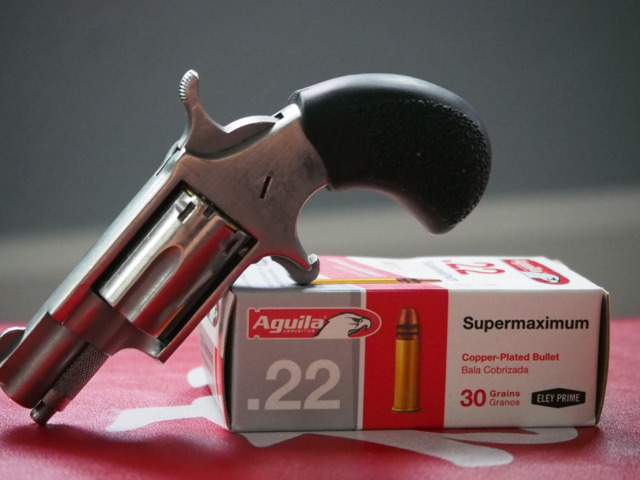 While we were testing out Oehler 35P Chronograph set up, we ran some Aguila 22 Supermaximum rounds through a North American Arms 22LR with a 1 1/8 " barrel. These turned out to be the fastest bullets we have ever put through this gun. Even the fastest 22 LR rounds rarely break 850 FPS. These bullets These went consistently over 1000 FPS.Officer Media Group, Lindsey Bertomen photographer
While we were testing out Oehler 35P Chronograph set up, we ran some Aguila 22 Supermaximum rounds through a North American Arms 22LR with a 1 1/8 " barrel. These turned out to be the fastest bullets we have ever put through this gun. Even the fastest 22 LR rounds rarely break 850 FPS. These bullets These went consistently over 1000 FPS.Officer Media Group, Lindsey Bertomen photographerAfter we set up our Oehler 35P Chronograph, we test to make sure everything is working. The 35P is considered one of the most accurate portable chronographs money can buy, and our testing team has been using one for may years. Before we do the testing, we test it, before testing cartridges. The gelatin has to be calibrated using a bb gun, which is part of the FBI protocol. Ideally, a bb fired at about 590 fps has to penetrate the block about 8.5 cm.
I usually just shoot a known cartridge through the chronograph screens. I use a .22, because I usually have one around. I thought I had a semi auto pistol, but all I had was my North American Arms NAA 22. This is a .22LR 5 shout revolver with a 1 1/8” barrel. I was thinking, “This will have to do.”
My crew member fired the first round across the screens, and it was just shy of 1050 fps. The fastest 22 cartriges run through this barrel at 650-850 fps, so this was unusual. Usually, we carry solid point .22LR rounds in pistols, because, at these slow velocities, hollow points and solid points work the same. Figuring we crossed the cables on the chronograph or something, we made the range safe and checked it.
It checked out, so we fired again. This one went over 1,000 fps. Almost all of them did. This was a mystery. The headstamp was Aguila, so I went to my range bag to see which Aguila rounds I had loaded into my Mini. They were 30 grain Aguila .22 Supermaximum cartridges, with plated soft point bullets. These bullets were designed for about 1700 fps in a rifle, but they set a new record in my pistol. The Aguila has claimed the Supermaximum is the fastest .22 LR on the market today. My data supports this claim, at least for an NAA Mini. Aguila has thrown down the gauntlet for micro guns.
About the Author

Officer Lindsey Bertomen (ret.), Contributing Editor
Lindsey Bertomen is a retired police officer and retired military small arms trainer. He teaches criminal justice at Hartnell College in Salinas, California, where serves as a POST administrator and firearms instructor. He also teaches civilian firearms classes, enjoys fly fishing, martial arts, and mountain biking. His articles have appeared in print and online for over two decades.
